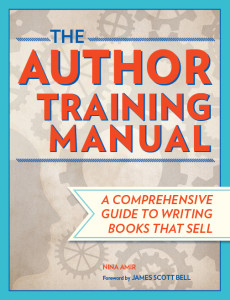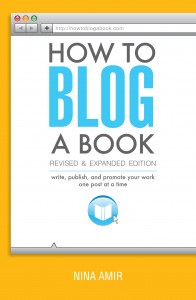 When you begin your blogged book—or any book—an overview of the entire book idea helps you get focus and clarity on the project. When you are clear about your topic, the angle you from which you will approach it, and how you will provide benefits to a particular audience, you can determine if the project is one worth pursuing. You’ve also got a starting point for the rest of your business plan and the writing of your manuscript.
When you begin your blogged book—or any book—an overview of the entire book idea helps you get focus and clarity on the project. When you are clear about your topic, the angle you from which you will approach it, and how you will provide benefits to a particular audience, you can determine if the project is one worth pursuing. You’ve also got a starting point for the rest of your business plan and the writing of your manuscript.
The first section of a business plan (or book proposal) provides an appropriate and effective first step toward blogging your book. Called the Overview, it helps you determine what your book is about and why someone would want to read it, which means buy it. It also helps you consider the full scope of your book’s concept.
I’ve written extensively here on this blog about the parts of your business plan and the “proposal process,” also called the Author Training Process. How to Blog a Book contains an entire chapter on the subject. I also wrote an entire book about it—The Author Training Manual. (That’s how important I feel business plans are to the process of producing marketable books.)
As I work with my Author Coaching and Blog-to-Book Coaching clients, I lead them through a three-step process to help them put together the essential pieces of their Overview. You can develop yours using the same three steps.
Step 1: Write Your Pitch
The first step involves writing the pitch or elevator speech for your book. This 100-or-so-word statement should include:
- an indication of your book’s target market
- a sense of what will make your book unique and necessary
- the clear benefits it will offer readers.
If you are writing a novel, convey the essence of the story line as well.
I love James Scott Bell’s perspective on pitching, which I included in The Author Training Manual. His formula, like most of the Overview, helps you create not only a pitch but content for the back cover of your book.
Here’s Jim’s formula for nonfiction writers:
 Sentence 1: most gripping question + the specific answer
Sentence 1: most gripping question + the specific answer- Sentence 2: In [title of book] + you will learn…..
- Sentence 3: about the author (Who the hell are you?)
Here is Jim’s formula for fiction:
- Sentence 1: character name + vocation + initial situation.
- Sentence 2: when + the doorway of no return (inciting incident)
- Sentence 3: now + death overhanging (physical, profession or psychological death)
Some pitches include a sentence that compares the book with two others, like this: [Your Book Title] is like [Book Title] meets [Book Title]. A comparison like this adds a unique descriptor based on the books mentioned.
Once you have a working pitch, you have gained clarity about what you want to write, who the book will benefit and what value you will offer readers.
Step 2: Elaborate on the Important Elements of Your Book
Imagine that you had used your pitch on a prospective book buyer or a literary agent. Intrigued with the book concept, the person responds by saying, “Tell me more.” What would you say?
Your answer provides the information for the next part of your Overview—a summary. Provide three to four bullet points or paragraphs that offer additional information about your book. For instance, you could:
- Mention the two or three turning points in your memoir or novel.
- Elaborate on benefits, features, or unique content.
- Describe the outstanding platform you have in your target market.
- Detail what makes you uniquely suited to write the book.
If you are writing a novel, you could provide a brief synopsis here as well.
Your pitch combined with this summary provides a description of your book and a clear picture of the book you want to write.
Step 3. List the Benefits You’ll Provide to Readers
 Now it’s time to focus on your readers. What value will you provide for them? Create a list of between three and ten benefits people will gain from reading your book.
Now it’s time to focus on your readers. What value will you provide for them? Create a list of between three and ten benefits people will gain from reading your book.
Benefits can be anything from a window into a unique life to a system that solves a problem to a story never heard before to specific steps for transformation.
Put it All Together
The three pieces of content you’ve created—a pitch, a summary, and a list of benefits—provide the foundational elements of the Overview for your blogged book’s business plan. They provide a big-picture view of the book you plan to write or blog. With this clarity, you can write the rest of your business plan.
At this point, you could begin blogging your book, but I don’t recommend that. It’s best to finish writing your business plan. Analyzing your book’s markets and competition helps you create the most marketable book. Additionally, these activities (and business plan sections) help you write the best possible book.
If you plan to approach a traditional publisher at some point, you’ll eventually want to polish the three pieces of content necessary for an Overview into a formal document. To do so, you’ll need to add:
- A compelling lead
- Information on the length of your book
- Information on any back matter you plan to include
- Additional information that describes how or why your book targets the needs or interests of your target market.
- Additional information that describes how your book is unique and necessary it its bookstore category.
I will discuss the latter two points in more detail in my next two posts, which will detail how to create the Markets and Competitive Titles sections of your book proposal or business plan. So keep the information on these topics brief in the Overview.
Of course, weave the details together in a skillful manner, so you provide a compelling and persuasive argument for the publication of the book.
If you plan to self-publish, your overview can remain a “rough draft” for your business plan—for your eyes only. But it should convince you that your idea is marketable and give your book idea some shape and substance.
Thank you for including a formula for pitching! That’s a super-helpful tip when clarifying the book in the initial stages.
I’m working through your book-blogging process right now, with the help of How To Blog A Book. It’s been a very useful tool for bringing blogging and book writing together.
You are welcome, Leanne.
Thanks,i feel i can write a book
This was amazing, thank you so much for the information.
WOW what an article really i mad of you ?Thank you so much! This was very helpful!